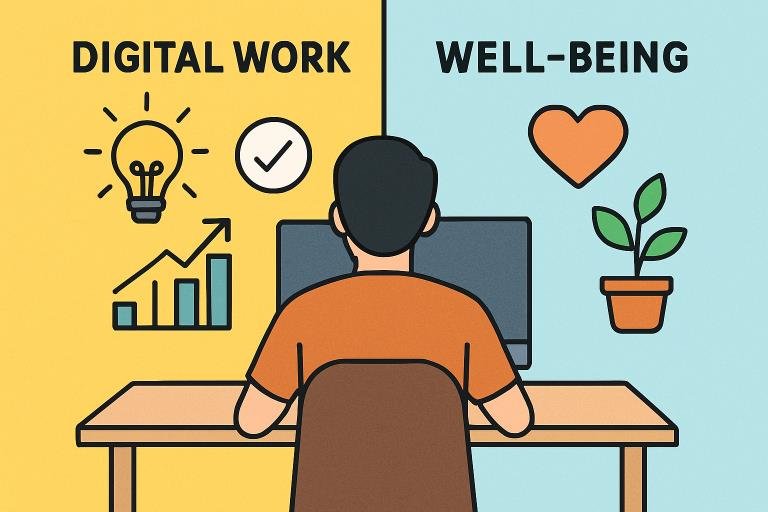Key Takeaways:
- Understanding the impact of constant digital connectivity on mental health and productivity.
- Recognizing the Signs of Digital Burnout and Technostress
- Implementing strategies to establish healthy digital boundaries.
- Leveraging technology to enhance well-being without compromising efficiency.
- Fostering a workplace culture that prioritizes digital wellness.
Introduction
In today’s digital-first world, the boundaries between work and personal life have been reshaped by an ever-present array of devices and applications. Digital tools and online platforms offer the promise of efficiency and flexibility, but constant connectivity can pose significant challenges. The question of how to balance high productivity with well-being and personal health is more pressing than ever.
The rise in remote work and digital communication means employees are now expected to be reachable at all hours. This persistent “always-on” mentality has given rise to new forms of stress — prompting a wave of products and solutions designed to address digital exhaustion. One such example, the Shift browser fights burnout, aims to help users reclaim control over their work-life balance by taming the avalanche of notifications and digital distractions.
The surge in digital engagement creates unprecedented connectivity, but it also blurs the lines between productive engagement and unhealthy overexertion. As the demands of digital life increase, it’s crucial to understand the warning signs of digital burnout and technostress—and how to counteract them. The journey to a healthy digital lifestyle requires a thoughtful, proactive approach that empowers individuals and organizations alike.
Recent studies highlight the importance of self-awareness and organizational support in combating technostress. As companies look to maintain high-performance teams, the well-being of their employees must remain a foundational priority.
The Rise of Digital Connectivity
The workplace revolution sparked by smartphones, high-speed internet, and cloud-based software has unleashed a wave of productivity tools and collaborative platforms. Teams collaborate across continents and time zones, and information is more accessible than ever. Yet, the shadow side of this progress is the “digital presenteeism” phenomenon: workers who, feeling pressured by company culture or fear of missing opportunities, stay perpetually connected, unable to disengage even after standard work hours.
This shift has increased expectations around responsiveness and availability. According to a recent Forbes article, workers often check messages late at night or on weekends, making it harder for them to disconnect from job demands mentally. This perpetual state of alertness usually leads to chronic stress and a lack of personal time, two key risk factors for digital burnout. Organizations must acknowledge these pressures to retain healthy, innovative, and loyal team members.
Understanding Digital Burnout and Technostress
Digital burnout is characterized by emotional, mental, and even physical exhaustion directly tied to sustained digital engagement. Symptoms may include irritability, sleep disturbances, and reduced concentration. Closely related is technostress—the unique form of anxiety stemming from constantly learning, adapting to, and managing new digital technologies.
A 2025 survey revealed that 64% of knowledge workers felt adversely affected by technology, with common complaints including digital overwhelm, notification overload, and decision paralysis. These conditions aren’t just personal matters: they impact team dynamics, creative output, and long-term organizational health. To thrive, both workers and leaders need to understand these risks and proactively identify the signs of digital fatigue.
According to research from Forbes, effective interventions hinge on a mix of education, realistic expectations, and supportive technology policies—essential ingredients as businesses continue to digitize their operations.
Establishing Healthy Digital Boundaries
Mitigating the negative impact of digital overload starts with establishing clear, enforceable boundaries. Here are some key strategies:
- Designate offline hours: Block time each evening or weekend for work-free leisure and family engagement. Switch off notifications or utilize “do not disturb” modes to enforce these periods.
- Utilize digital silence: Set aside specific times of the day for deep work, free from interruptions from chat or email. This “digital silence” supports focus and mental clarity.
- Promote disconnection after hours: Encourage both management and team members to refrain from work-related communications outside of established working hours, which helps sustain motivation and satisfaction in the long term.
Successful boundaries depend on both personal discipline and clear organizational policies. Employees are more likely to take advantage of downtime when leadership models and supports these behaviors.
Leveraging Technology for Well-Being
Technology is not inherently the enemy. When used thoughtfully, it can empower users to enhance well-being and performance simultaneously. Apps like AdaptAI monitor stress cues and recommend interventions, while wearable devices provide real-time feedback on health indicators, including step counts, rest periods, and even mindfulness prompts.
These advances provide employees with practical tools to monitor their habits and adjust their workflows, making them more resilient to the pressures of remote collaboration and excessive screen time. Moreover, features such as automatic scheduling of microbreaks or digital detox reminders are becoming standard on many platforms, reinforcing positive behaviors without demanding extra effort.
Fostering a Culture of Digital Wellness
Healthy digital boundaries are most sustainable when supported by organizational culture. Companies can make a substantial difference by:
- Establishing clear guidelines that discourage after-hours messaging and email.
- Providing ongoing education on smart use of collaborative tools and stress-reduction strategies.
- Regularly evaluating employee well-being and seeking feedback on digital policies, ensuring they remain aligned with both business goals and health priorities.
Successful organizations treat digital wellness as a cornerstone of their mission, embedding well-being into performance expectations and workplace practices.
Conclusion
As workplaces continue their digital evolution, balancing productivity and well-being is both a personal and organizational imperative. The strategies discussed—from boundary setting to workplace culture—are essential in combating digital burnout and fostering healthier, happier workplaces. By making intentional choices and adopting supportive technology, companies and individuals alike can thrive in the digital age, ensuring both high performance and lasting well-being.



